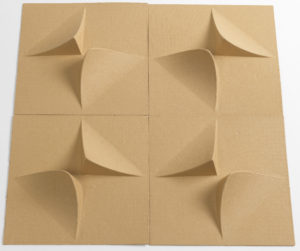Of the 10,000 plus wallpapers in the Cooper Hewitt collection this piece is not the most visually exciting. But it is significant. This CoverAge product is possibly the earliest wallpaper made from 100% recycled materials. The paper is made from post-consumer paper and cardboard along with wood bits salvaged from old pallets and scrap wood, with the wood particles sandwiched between layers of paper. No formaldehyde was used in its production. Given the product’s makeup it wears the Blue Angel environmental label. The Blue Angel (Der Blaue Engel) is a German certification for products and services that have environmentally friendly aspects and is the oldest ecolabel in the world.
CoverAge is available in five different textures, from Flat, containing very fine particles with a low relief, to the super chunky Exclusive. The paper is meant to be painted after installation creating the look of old plaster. Not only does it add a subtle texture to the wall it also hides cracks and other wall imperfections.
Wallpapers and wallcoverings have come a long way since the 1990s. More companies are producing wallcoverings with natural and recycled materials, fewer toxins are used in their production, and vinyl can be produced without PVCs.
Reading all the stats on this paper brings to mind a similar product, the V2 Wall Tile, one of the early wallcoverings made by Mio Culture in Philadelphia. Like CoverAge, these wall tiles are made from 100% recycled post-consumer paper and offer some relief for the wall. However, the wall tiles are embossed with a high relief, offering a depth of about two and one half inches. These are also designed to be painted after installing, and can be recycled when no longer desired. So here is to putting more paper on our walls and less in landfills.

